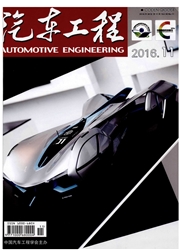

 中文摘要:
中文摘要:
汽车自适应巡航控制系统根据本车与前车之间的相对距离和相对速度,综合考虑车间行驶安全性、本车纵向动力学特性和驾乘人员的舒适性等多个相互关联且存在一定矛盾的性能指标,实现本车与前车安全车间距的保持控制。针对这一多目标协调控制问题,本文在动态输出反馈控制框架下,模拟真实驾驶员对车间距控制的行为特性,利用汽车行驶状态和控制变量建立了安全性、轻便性、舒适性和工效性指标,进而基于不变集和二次有界性理论提出了以上多性能指标的动态协调控制机制,建立了一套自适应巡航控制系统的车间距控制算法。最终通过跟随、驶离和切入3种典型工况的仿真,验证了算法对安全车间距保持和协调多性能指标的可行性和有效性。
 英文摘要:
英文摘要:
According to the distance and relative velocity between host vehicle and preceding vehicle, the adaptive cruise control (ACC) system concurrently considers three correlated and contradictory performance indica- tors of driving safety between vehicles, longitudinal dynamics characteristics and the comfort performance of driver and occupants to achieve the control for maintaining safe inter-vehicle distance. Aiming at this multi-objective coor- dinated control problem, the behavior characteristics of real driver in inter-vehicle distance control are simulated un- der the framework of dynamic output feedback control and four indicators of safety, handiness, comfort and efficien- cy are set up based on the driving state and control variables of vehicle. Then a dynamic coordinated control mecha- nism for above-mentioned performance indicators is proposed based on invariant set and quadratic boundedness theo- ry and a set of inter-vehicle distance control algorithms for ACC system are worked out. Finally simulations on three typical operation conditions (following and the cut-out and cut-in of preceding vehicle) are conducted to verify the feasibility and effectiveness of the proposed algorithms in safe inter-vehicle distance maintenance and multi-perform- ance indicators coordination.
 同期刊论文项目
同期刊论文项目
 同项目期刊论文
同项目期刊论文
 期刊信息
期刊信息
